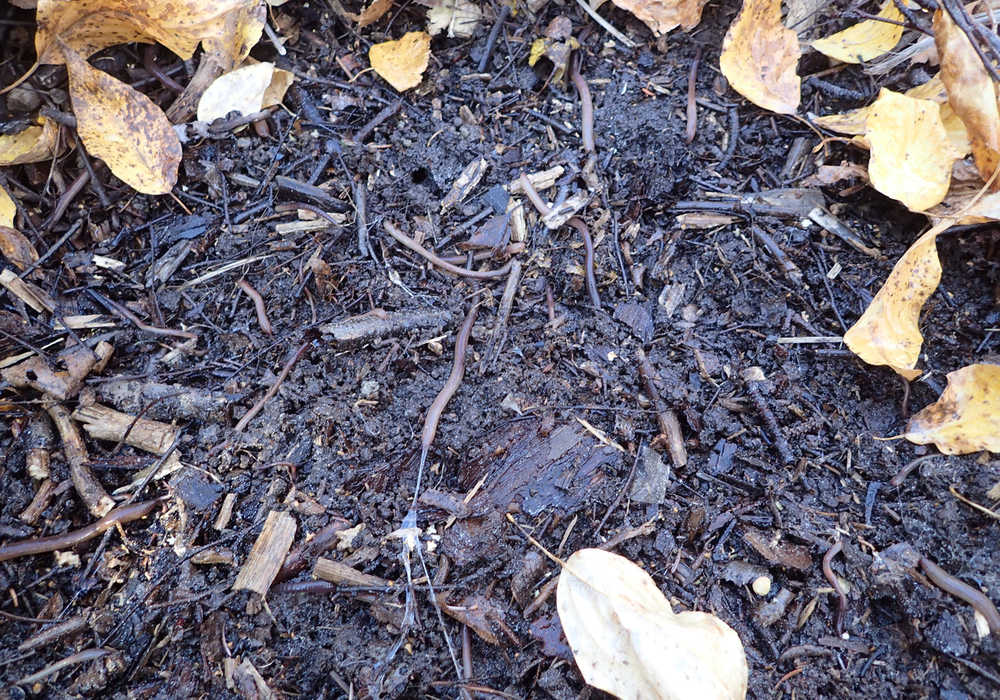Last month when I stepped into the woods after a day’s work on Stormy Lake I saw a sight I had seen only in pictures from the Upper Midwest. “Oh my goodness!” I declared as a question of mine was immediately, strikingly answered.
The upper soil layers were completely gone! Here, under cottonwoods, birches, alders, and devil’s club, the forest floor should have been blanketed with a thick carpet of last fall’s leaves and several inches of decomposing leaf litter underneath. These thick layers had disappeared, leaving formerly underground tree roots exposed. This is exactly the same story that played out around the Great Lakes, where exotic earthworms removed the upper soil layers at rates of up to three inches per year, baring tree roots and leading to real ecological changes.
Earthworms first came to the attention of biologists at the Kenai National Wildlife Refuge in 2010. This concern culminated in research led by Deanna Saltmarsh, an Alaska Pacific University graduate student, who reported on the distribution and abundance of exotic earthworms on the Refuge (http://bit.ly/2dWpgVn). We now have a good idea of which earthworm species are present, where they tend to occur, and even how they got there, but we had not previously seen any real consequences of this invasion on the Kenai Peninsula.
Now we know, and the answer is “yes,” earthworms do and will change things here.
I returned to Stormy Lake last week to find out which earthworm species were culpable and to measure how much soil had been lost. Pouring mustard solution on the ground, which irritates earthworms, brings them “screaming” to the surface. The results were definitely impressive at Stormy Lake. I could have filled jars with European nightcrawlers longer than my hand fleeing the temporarily caustic soil. In smaller numbers were two other exotic earthworm species — octagonal-tail worms and gilt-tail worms.
Up to nine vertical inches of soil have been removed here, leaving tree roots completely suspended above the ground in places. All leaf litter was consumed; only leaves that fell recently graced the ground. Under the new leaves a continuous, shallow covering of worm castings covered mineral soil.
We know now that exotic earthworms can remove the upper soil layers here as has happened in the Upper Midwest, but what will this mean for plants and animals of the Kenai Peninsula? You probably learned that earthworms are good for garden plants, and this is generally true. Earthworms do make a garden richer, speeding the decomposition of organic matter, so some plants benefit. And here on the Kenai, some earthworm predators such as American robins and even coho salmon make good use of this previously unavailable food resource.
The flipside is that what is beneficial to some species may be detrimental to other species. In the Great Lakes region, earthworms have caused local declines in animals and plants that depend on a thick leaf litter layer including ovenbirds, red-backed voles, shrews, salamanders, shield ferns, and star flowers.
We can make educated guesses as to how plants and animals on the Kenai Peninsula might respond as earthworms spread and alter soil properties. Of our forest types, spruce and hemlock should be impacted the least because most earthworms do not like the acidic soils of conifer forests.
Hardwood forests, such as what surrounds Stormy Lake, are where changes should be most dramatic. Here, understory plants like ferns, star flowers, and watermelon berries are likely to decline while grasses may become more abundant. Our voles and shrews may be disfavored by the loss of leaf litter while robins stand to benefit.
Earthworms, especially European nightcrawlers, also have the potential to change our forests more directly by eating seeds — lots of them. They prefer smaller seeds like birch over larger seeds like spruce, removing up to 100 percent of birch seeds deposited on the soil surface, but worms are probably less important seed consumers than rodents in natural settings.
Thankfully, earthworms generally do not get around well on their own, spreading at a glacial rate of less than 30 feet per year. The nightcrawlers at Stormy Lake, as with populations established at Canoe Lake and other popular fishing lakes on the Kenai Peninsula, were almost certainly released there by anglers. Even at Stormy Lake, it appears that only an acre next to the boat launch has been dramatically affected by earthworms to date. One hundred yards up the access road I found a thick, intact layer of decomposing leave litter and only one nightcrawler. Three hundred yards away near the Spur Highway I found no nightcrawlers.
We can still truly say that most of our natural landscape has been little changed by European earthworms being introduced to the Kenai. But now we know that this is beginning to change, dramatically so in some places.
Matt Bowser serves as Entomologist at the Kenai National Wildlife Refuge. You can find more information at http://www.fws.gov/refuge/kenai/ or http://www.facebook.com/kenainationalwildliferefuge.

